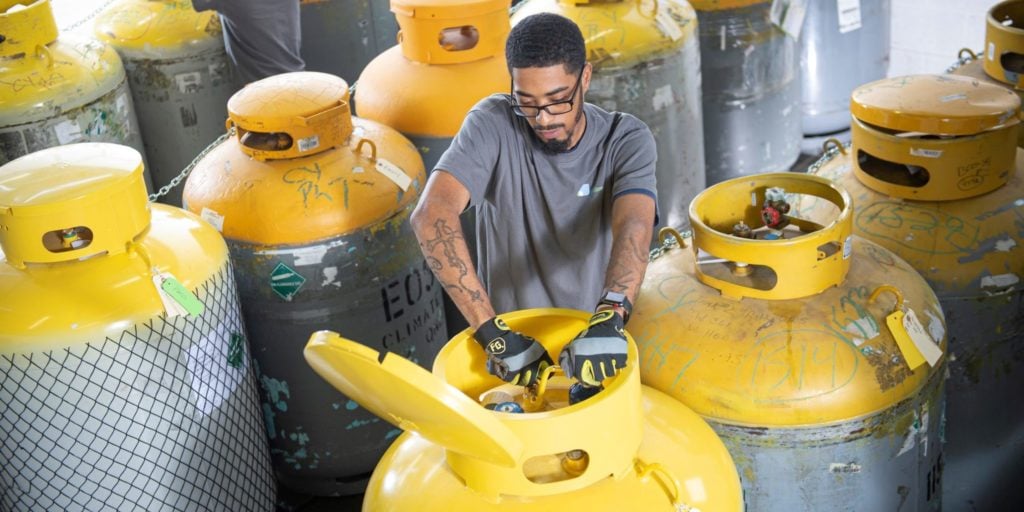Get Paid to fight climate change
by selling old & used refrigerants
You may be sitting on some of the most potent greenhouse gases ever created: old refrigerants. These climate-warming gases are more than 10,000 times more potent than CO2 and often go unnoticed in outdated HVAC units, older cars, and other refrigerated systems. When you sell us your old refrigerant, you are ensuring the permanent destruction of these greenhouse gases.
We are the only climate-focused refrigerant buyback program in the world.

Destroying climate bombs
Are you familiar with the hole in the ozone layer? CFC refrigerants are responsible for the deterioration of this protective layer. Shortly after this discovery in 1987, the Montreal Protocol banned the global production of CFCs. Although it is illegal to manufacture these refrigerant gases, there are no laws preventing the ongoing use of CFC refrigerants.
We are the only company ensuring the destruction of these harmful CFC refrigerant gases before they leak into the atmosphere.
Make an impact
Mitigate climate change by permanently preventing the release potent greenhouse gases.
Get paid to do it
You can get paid in cash, check, or e-payments like PayPal.
Choose your collection method
You can choose between local pick-up, drop-off, or mail-in options.
How it works
Tradewater is an EPA-certified reclaimer with the technical expertise to handle refrigerant safely and responsibly. Unlike others who purchase refrigerant, however, we do this work solely for the purpose of fighting climate change.
We first aggregate the dangerous greenhouse gases we collect. After aggregation, we ensure the safe destruction of the gases through incineration.
By selling your refrigerant to us, you are making a positive, measurable impact on the environment. You can be sure that the gases will be destroyed and never leak into the atmosphere.
We first aggregate the dangerous greenhouse gases we collect. After aggregation, we ensure the safe destruction of the gases through incineration.
By selling your refrigerant to us, you are making a positive, measurable impact on the environment. You can be sure that the gases will be destroyed and never leak into the atmosphere.
Together, we can reduce the world’s carbon footprint by collecting and destroying the most powerful greenhouse gases.

Make the world better while making money
Tradewater has prevented the equivalent of over 6.7 million tons of carbon dioxide from being released to the atmosphere. We have also invested over $32.5 million back into local communities worldwide through our buyback and collection programs. You can help us destroy even more greenhouse gases—while getting paid.
Previous
Next
Meeting your refrigerant needs
Our experienced technicians will safely and responsibly handle refrigerant recovery and ensure that the process is smooth and cost-effective.
Already have the expertise and equipment to perform your own recovery? We can also provide DOT certified cylinders for you to complete the refrigerant recovery yourself and, in many cases, pay competitive prices for your refrigerant.
Together, we can reduce the world’s carbon footprint by collecting and destroying the most powerful greenhouse gases.

Mechanical contractors
We will perform chiller recoveries to EPA-required standards and keep the admin burden low and the process transparent.
Building owners
We provide top-notch refrigerant solutions, making the process smooth and easy.
Salvage operators & riggers
We offer quick refrigerant recovery services nationwide along with competitive refrigerant buy-back pricing.

Don't have refrigerants?
If you don't have any CFC refrigerants, Tradewater offers other ways for individuals and businesses a-like to get involved in the fight against climate change. By supporting us, you are directly helping in the hunt to seek out and destroy these potent greenhouse gases around the world.
Carbon offset credits
Make an impact by purchasing the carbon offset credits that finance our work. Discover your emissions with our easy to use carbon calculator.
The Carbon Neutral Collective
Sign up your small business and get the tools you need to measure, manage, and offset your emissions.
Refrigerant solutions
Learn how your company can lead the way toward responsible refrigerant management practices.
©2024 Tradewater
Tradewater generates carbon offset credits by collecting and permanently destroying harmful greenhouse gases (GHGs) in the form of refrigerant gases through a safe, verifiable process. If not destroyed, these GHGs would eventually be released into the atmosphere.
Permanence
Emission reductions are considered permanent if they are not reversible. In some projects, such as forestry or soil preservation, carbon offset credits are issued based upon the volume of CO2 that will be sequestered over future decades—but human actions and natural processes such as forest fires, disease, and soil tillage can disrupt those projects. When that happens, the emission reductions claimed by the project are reversed.
The destruction of halocarbon does not carry this risk. All destruction activities in Tradewater’s projects are conducted pursuant to the Montreal Protocol , which requires “a destruction process” that “results in the permanent transformation, or decomposition of all or a significant portion of such substances.” Specifically, the destruction facilities Tradewater uses must meet or exceed the recommendations of the UN Technology & Economic Assessment Panel , which approves certain technologies to destroy halocarbons, including the requirement that the technology achieve a 99.99% or higher “destruction and removal efficiency.” Simply put, this means that Tradewater’s technologies ensure that over 99.99% of the chemicals are permanently destroyed. During the destruction process, a continuous emission monitoring system is used to ensure full destruction of the ODS collected.
Accuracy
Some carbon offset projects necessarily rely on estimations or assumptions when calculating the emission reductions from project activities. Forestry projects, where developers make assumptions about the carbon that will be sequestered over future decades if trees are conserved, are a perfect example. Such projects sometimes result in an overestimation of the environmental benefit of the project.
Tradewater’s halocarbon projects avoid the issue of overestimation by consistently conducting extremely precise testing and measurement of the amount of refrigerant destroyed in each project.
Additionality
It is a basic requirement of all carbon offset projects that the underlying project activities are additional. “Additional” means that the projects would not happen in the absence of a carbon market. Tradewater’s halocarbon projects simply would not happen – and the gases would be left to escape into the atmosphere – without the sale of the resulting carbon offset credits. This is because there is no mandate to collect and destroy these gases. It is still permissible to buy, sell, and use halocarbons that were produced before the ban. There are other reasons halocarbon destruction projects are additional:
- There are no incentives or financial mechanisms to encourage halocarbon destruction. According to the International Energy Agency and United Nations Environment Program, “there is rarely funding nor incentive” to recover and destroy ozone depleting substances in storage tanks and discarded equipment. And collecting, transporting, and destroying halocarbons is time-intensive and expensive. The burden to collect and destroy these gases therefore remains prohibitive outside of carbon offset markets—meaning that if organizations like Tradewater do not do this work, nobody else will.
- Countries are not focused on the need to collect and destroy halocarbons. The Montreal Protocol has been celebrated as a success because of its production ban. This success, however, ignores the legacy gases produced before the ban and is a blind spot for government regulators. In the U.S., for example, the Environmental Protection Agency (EPA) developed a Vintaging Model in the 1990s to estimate the quantify of ozone depleting substances left in circulation. Based on the inputs and assumptions put into the model, the EPA predicted that no CFCs would be available for recovery beyond 2020 in the United States. But this prediction did not prove accurate. Tradewater has collected and destroyed more than 1.5 million pounds of CFCs globally in recent years and continues to identify thousands of pounds per week.
- International carbon accounting standards do not require corporations to measure or track emissions tied to halocarbons, and refrigerants are specifically excluded from Science Based Targets initiative (SBTi) commitments. These commitments derive from emissions reporting under the GHG Protocol, which requires companies to report on emissions only from new generation refrigerants, such as hydrofluorocarbons (HFCs), but does not establish any obligation to report inventories or emissions of refrigerants still in use, such as CFCs and HCFCs. All these factors combine to make Tradewater’s carbon offset projects highly additional. As Giving Green, an initiative of IDinsight, concluded: “Tradewater would not exist without the offset market, so this element of additionality is clearly achieved.” The case for additionality is not so clear for some other project types, such as forestry and landfill gas carbon projects. For example, some forests are already being conserved for their beauty, or for use as parks, and generate carbon offset credits only because those conservation efforts do not yet have full formal protection in place to avoid deforestation in the future. Similarly, methane from landfills can be used to make electricity or captured as compressed natural gas, thereby creating additional revenue streams to support the activities, beyond the sale of carbon credits.
